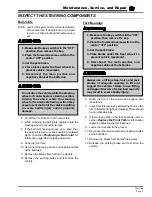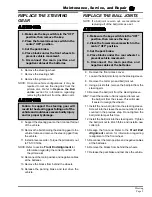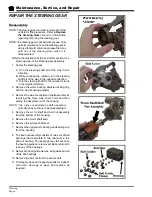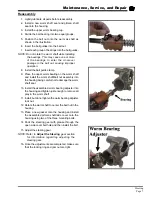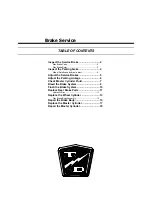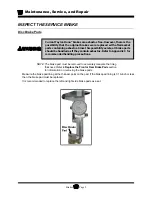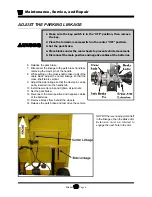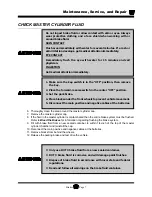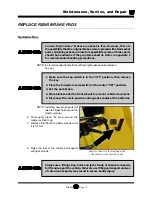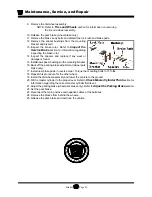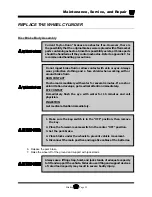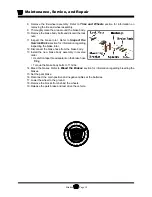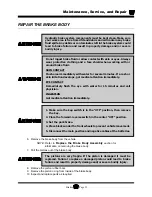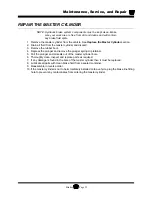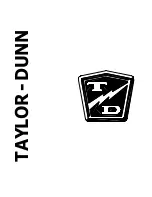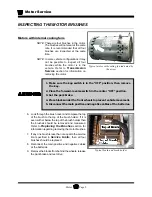
Maintenance, Service, and Repair
Brakes
Page 9
7. Add brake fluid from a new sealed container to the master cylinder. Fill to 1/4” from the top of
the master cylinder chamber.
8. The master cylinder fluid level will drop as the brakes are bled. Periodically check and fill the
master cylinder during this procedure. Do not allow the fluid level in the master cylinder to drop
too low as this will allow air into the brake lines.
9. Attach a clear hose to the bleeder valve on the brake
cylinder that is to be bled. Route the hose into a
clear container for waste brake fluid.
10. Pump the brake pedal a few times and then press
and hold light pressure to the brake pedal.
11. Open the bleeder valve on the hydraulic brake body.
12. Depress the foot pedal to the floor and then close
the bleeder valve. Do not release pressure on the
brake pedal until the bleeder valve is closed.
13. Slowly release the foot pedal, allowing it to return
to its released position.
NOTE: Check and fill the master cylinder frequently during the bleeding
process. Do not allow the fluid level in the master cylinder to drop
low enough to allow air to enter the brake lines. If air enters the
brake lines during the bleeding process, then you will have to start
again from the beginning.
14. Repeat the above steps until you are sure that all of the air is expelled from the brake line. Any
air bubbles that can be seen in the clear hose attached to the bleeder is an indication that there
is still air in the brake lines.
15. Repeat this process with each of the other wheels.
NOTE: When finished, top off the master cylinder with fluid. See
Check
Master Cylinder Fluid
for information on filling the master
cylinder.
16. Reconnect the main positive and negative cables at the batteries.
17. Remove the blocks from behind the wheels.
18. Release the park brake and test drive the vehicle.
Always use brake fluid from a new sealed container. Never reuse any
brake fluid that has been removed from the brake system. Use of
contaminated brake fluid will degrade the braking performance and
may cause property damage or severe bodily injury.
•
Only use DOT 3 brake fluid from a new sealed container.
•
DOT 3 brake fluid is corrosive and will damage paint finishes.
•
Dispose of brake fluid in accordance with local state and federal
regulations.
•
Read and follow all warnings on the brake fluid container.
Bleeder valve with hose attached
Summary of Contents for MB-238-00
Page 2: ......
Page 6: ...TAYLOR DUNN...
Page 28: ...TAYLOR DUNN...
Page 44: ...Maintenance Service and Repair Steering Page 8 Exploded View of Steering Gear...
Page 64: ...TAYLOR DUNN...
Page 112: ...TAYLOR DUNN...
Page 149: ...TABLE OF CONTENTS Wire Diagrams Complete Vehicle 2...
Page 158: ...Illustrated Parts Parts Page 8 Transmission Gear Case...
Page 162: ...Illustrated Parts Parts Page 12 Rear Brakes Brake Body Assembly...
Page 166: ...Illustrated Parts Parts Page 16 Brake Lines Illustration not available...
Page 168: ...Illustrated Parts Parts Page 18 Motor...
Page 170: ...Illustrated Parts Parts Page 20 Wheels and Tires Ref wheel hub 1 2 3 Rear Suspension...
Page 172: ...Illustrated Parts Parts Page 22 Speed Control Panel Instrument Panel dash...
Page 182: ...Illustrated Parts Parts Page 32 Seat Cushions Deck and Lights Frame Illustration not available...
Page 184: ...Illustrated Parts Parts Page 34 Decals...

